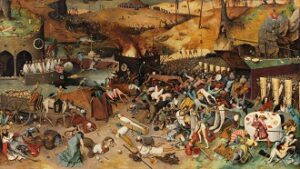
Mass culture and its criticism
In Morin’s book “The Mass Culture of the Twentieth Century”, it is stated that there is a zone “where the distinction between culture and mass culture becomes purely formal: The Human Condition, Nausea or The Plague enters the culture of mass without, however, leaving the cultivated culture” (Morin, 1997, p. 53) and Camus’ book is interesting for its coincidence with the issue of the current Pandemic, and interesting that it did not enter into the analysis of the cultural aspect of the moment.
it is stated that there is a zone “where the distinction between culture and mass culture becomes purely formal: The Human Condition, Nausea or The Plague enters the culture of mass without, however, leaving the cultivated culture” (Morin, 1997, p. 53) and Camus’ book is interesting for its coincidence with the issue of the current Pandemic, and interesting that it did not enter into the analysis of the cultural aspect of the moment.
We have already posted on the blog at another time about Camus’ book “The Myth of Sisyphus” and oher about José Saramago’s novel Essay on blindness (1995), although widely read in some European countries amidst the pandemic, his analysis was not entered the circles of cultural “high narrative”, that we tried to explain in some posts this week.
Written in 1947 by the weak Algerian Alberto Camus, its origin is important, because its chronicle starts from an analysis of an epidemic that occurred in the Algerian city of Oran, in some year of the 1940s, when Camus worked clandestinely in the clandestine newspaper “ Combat!” where he wrote texts engaged against Nazism, among them “Letters to a German Friend” (1945) stand out.
The book deals with the absurdity of existence, when in the midst of an epidemic there is a lack of love and human solidarity, whose feelings can be summarized where he wrote: “There were common feelings, such as separation or fear, but the personal concerns.
No one had yet truly accepted the disease”. Another excerpt that can be highlighted: “Many continued to hope that the epidemic would cease and that they, with their families, would be spared. As a result, they still didn’t feel obligated to do anything.
The plague was nothing more to them than an unpleasant visitor who would one day depart. Frightened but not desperate, the moment had not yet come when the plague would appear to them as the very form of their life and when they would forget the existence they had been able to lead until then.”
With the war just over in the period that he wrote the book, he remembers: “The scourges, in fact, are a common thing, but it’s hard to believe in them when they befall us. There were an equal number of pests and wars in the world. And yet, plagues, like wars, always find people equally unprepared.”
He shrewdly analyzes the scourges in history: “From the beginning of history, the scourges of God have brought the proud and the blind at his feet. Meditate on this and I fell to my knees.” and adds: “Oh, if it were an earthquake! A good shake, and there was no more talk about it… counting the dead, the living, and that was it. But this damn disease! Even those who don’t catch it seem to carry it in their hearts.”, and his conclusion brings a reflection: “The more the pandemic spreads, the more the moral will become elastic.”
I understood that the absence of solidarity and compassion, as well as the elasticity of morality were not unusual facts in epidemics, but somewhat expected, but I would add that there is always a more humane, more solidary alternative that gives us the hope of a much more just after a sad scourge, learn something from it.









